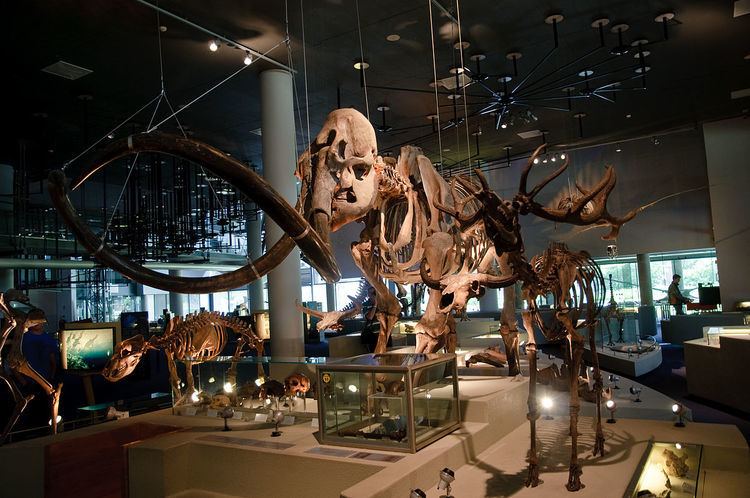Collection size 37 million objects Height 62 m Founded 1984 | Visitors 339,550 (2015) Phone +31 71 751 9600 Director Edwin van Huis Architect Fons Verheijen | |
 | ||
Established 9 August 1820 (1820-08-09) Type National museumNatural history museumResearch center Collections zoology, botany, geology Similar Rijksmuseum van Oudheden, National Museum of Ethnology, Hortus Botanicus Leiden, Corpus, Museum Boerhaave | ||
Tyrannosaurus rex thighbone by naturalis biodiversity center ultimaker 3d printing timelapse
Naturalis Biodiversity Center (Dutch: Nederlands Centrum voor Biodiversiteit Naturalis) is a national museum of natural history and a research center on biodiversity in Leiden, Netherlands. Although its current name and organization is relatively recent, its history can be traced back to the early 1800s. Its collections contain approximately 37 million specimens, one of the largest natural history collections in the world. In late 2016 the center closed its main building for renovations, with plans to re-open in late 2018. Temporary exhibitions are open in the pesthuis entrance building during the renovations.
Contents
- Tyrannosaurus rex thighbone by naturalis biodiversity center ultimaker 3d printing timelapse
- Herbarium digitisation 4m in 1 5 years for naturalis biodiversity center
- History
- Collection
- Travellers
- Permanent exhibitions
- Temporary exhibitions
- Visitors
- References
Herbarium digitisation 4m in 1 5 years for naturalis biodiversity center
History
The beginnings of Naturalis go back to the creation of the National Museum of Natural History by King William I on August 9, 1820. In 1878, the geological and mineralogical collections of the museum separated into two institutions. These remained distinct until the merger of the Rijksmuseum van Natuurlijke Historie (abbreviated RMNH) and the Rijksmuseum van Geologie en Mineralogie (abbreviated RGM) in 1984, as the Nationaal Natuurhistorisch Museum (NNM) or National Museum of Natural History.
In 1986, it was determined that the institution should become a public museum, and a new building was designed by Fons Verheijen. The building's reception area incorporated the 1657-1661 Pesthuis, designed by Huybert Corneliszoon van Duyvenvlucht. Completed in 1998, it was opened on April 7, 1998 by Queen Beatrix. The new building cost about €60 million, making it the second most expensive museum building in the Netherlands.
As of 2010, the National Museum of Natural History (Naturalis) further combined with the Zoological Museum Amsterdam (ZMA) of the University of Amsterdam, and the Dutch National Herbaria at the universities of Leiden, Amsterdam and Wageningen, to form the Nederlands Centrum voor Biodiversiteit (NCB Naturalis). The combined institute was formally opened as part of the ‘International Year of Biodiversity 2010’ by Ronald Plasterk and Gerda Verburg.
As of 2012 the name became the Naturalis Biodiversity Center. Naturalis has partnered with ETI Bioinformatics in support of the Catalogue of Life (CoL), and is working with the Global Biodiversity Information Facility. Funding is in place to support digitization of the massed collections. As of 2015, further renovation and expansion is planned, with a proposed design from Neutelings Riedijk Architecten to be completed in 2018. However, the Pesthuis will no longer be part of the complex.
Collection
The current museum is known for the numerous objects in its collections. Prior to the merger with the Zoölogisch Museum Amsterdam and National Herbarium of the Netherlands, there were approximately 10 million zoological and geological specimens in the Naturalis collection. Following the merger with the collections of the Zoölogisch Museum Amsterdam and National Herbarium of the Netherlands in 2010-12, there are now approximately 37 million specimens:
The largest part of the collections are stored in a 60-meter-high tower, a landmark in Leiden, opened in April 1998. Some parts of the collections are stored in a depot in the former museum building at the Raamsteeg in the city centre of Leiden.
Travellers
Among the collections at Naturalis are the papers and field notes of a number of early travellers and naturalists, including the following:
Permanent exhibitions
The museum has several permanent exhibitions:
Temporary exhibitions
Visitors
Naturalis had an estimated 285,000 visitors and was the 15th most visited museum of the Netherlands in 2013. The museum had a record number of 339,550 visitors in 2015.
